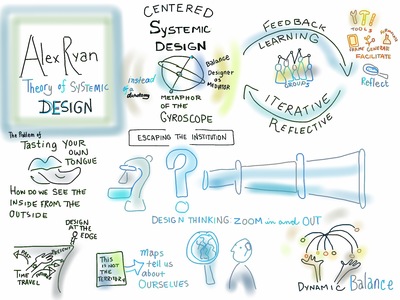A theory of systemic design
Ryan, Alex (2013) A theory of systemic design. In: Relating Systems Thinking and Design 2013 Symposium Proceedings, 9-11 Oct 2013, Oslo, Norway.
Preview |
Text
Ryan_Theory_2013.pdf Download (803kB) | Preview |
![Ryan_MindMap_2013.jpg [thumbnail of Ryan_MindMap_2013.jpg]](https://openresearch.ocadu.ca/2162/2.hassmallThumbnailVersion/Ryan_MindMap_2013.jpg)  Preview |
Image
Ryan_MindMap_2013.jpg Download (541kB) | Preview |
Abstract
Over the last two decades, concepts from complexity theory, systems thinking, design, strategy, and philosophy have been synthesized within the Israeli Defense Force, the Australian Army, and the U.S. Army and Joint Force to produce a theory and practice of systemic design. Although this conceptual evolution has taken place within a military context, the theory developed has general applicability to the challenges of designing at scale in complex environments. The purpose of this paper is to present the pure theory of systemic design as developed by Western militaries, but abstracted away from its military context, in order to facilitate applications to societal, governmental, and business design challenges. By making the theory accessible to civilian designers, it is hoped that they may benefit from the cross-pollination of ideas that have evolved in the highly competitive crucible of contemporary conflict.In part one, I provide a framework for systemic design consisting of three levels: methods, methodology, and, mindset. The uses and abuses of methods are discussed first. Next, the logic for a systemic design inquiry is outlined and developed as a flexible methodology for developing deeper understanding and constructing novel interventions. Then, the mindset of the systemic designer is characterized as a set of values and habits. Any systemic design inquiry proceeds at all three levels simultaneously, with the levels mutually reinforcing and reciprocally influencing one another.
In part two, I construct a model of systemic design as a learning system. This model shows how a cycle of iterative systemic design inquiry can function as an open system able to adapt to a changing environment. The learning system is comprised of six elements: inquiry, facilitating, framing, formulating, generating, and reflecting. All of these elements must be present and must work together to generate systemic improvement in a problematic situation.In part three, I discuss meta-concerns for systemic design. They include the rationale for systemic design, design of the design team, mediation of cognitive tensions, knowing when to depart from the systemic design methodology, and criteria for selecting and constructing methods that are both systemic and designerly.
| Item Type: | Conference/Workshop Item (Paper) |
|---|---|
| Divisions: | Faculty of Design |
| Date Deposited: | 30 Jan 2018 15:48 |
| Last Modified: | 20 Dec 2021 18:33 |
| URI: | https://openresearch.ocadu.ca/id/eprint/2162 |
Actions (login required)
 |
Edit View |

 Lists
Lists Lists
Lists